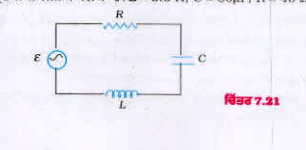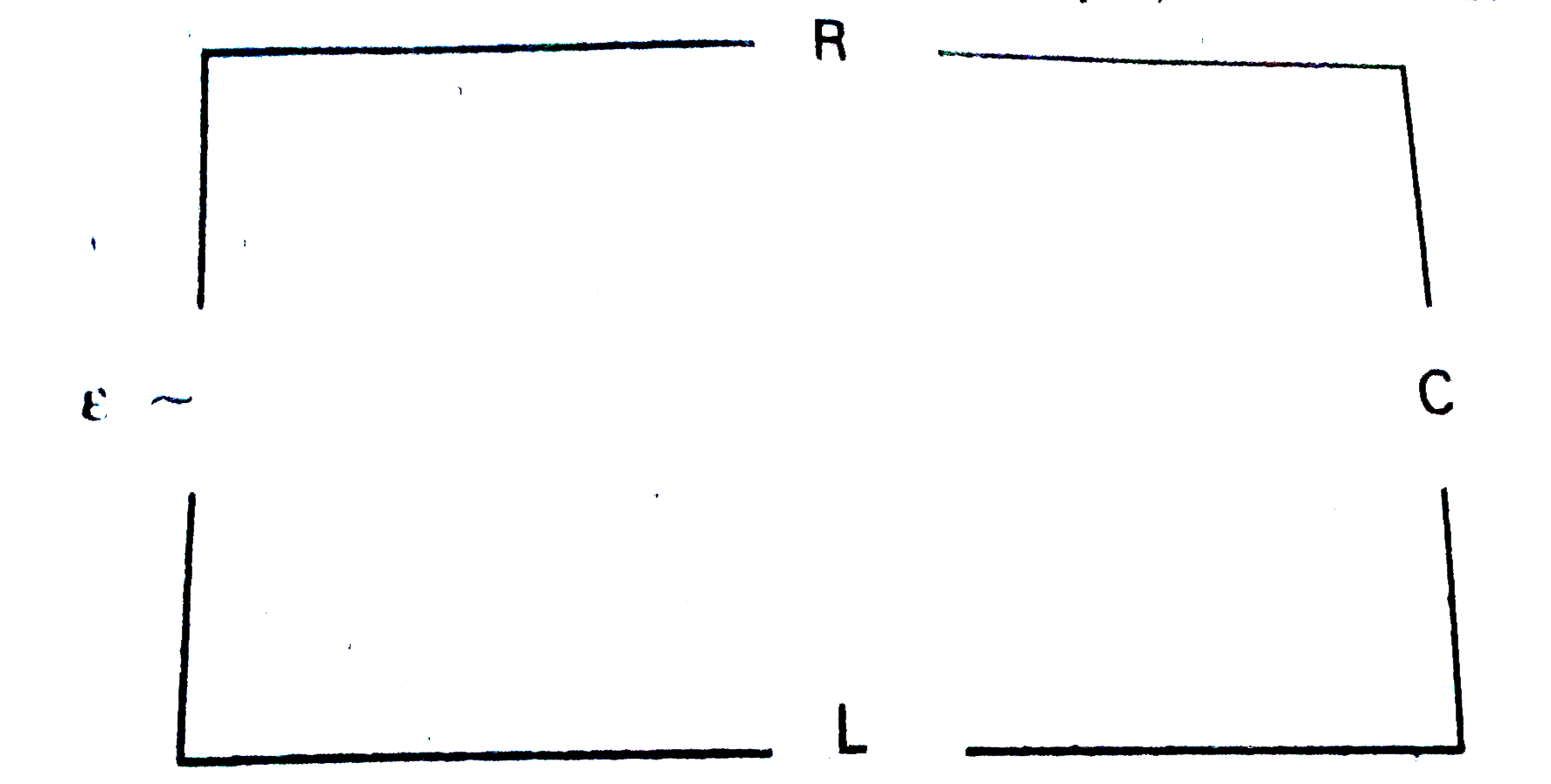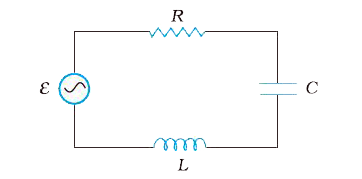The figure shows a series LCR circuit with L = 5.0 H C = 80 μF R = 40 Ω connected to a variable frequency of 240 V source. Calculatei The angular frequency of the source which drives the circuit at resonance.ii The current at the resonating frequency.iii The rms potential drop across the capacitor at resonance.
i ϕ = 1/√LCii Current at resonance
Related Solutions
Figure 7.21 shows a series LCR circuit connected to a variable frequency 230 V source. L = 5.0 H, C = 80 muF , R= 40 Omega . Determine the source frequency which drives the circuit in resonance. :
View SolutionFigure shows a series LCR circuit connected to a variable frequency 230 V source. .

Determine the source frequency which drives the circuit in resonance.View SolutionA series LCR circuit with and is connected to a variable frequency 240 V source. Calculate
(i) angular frequency of the source which drives the circuit in resonance,
(ii) current at the resonating frequency,
(iii) rms potential drop across the inductance at resonance.View SolutionA series LER circuit with , L = 5.0 H and is connected to a variable frequency 240 V a.c. source Calculate
(i) angular frequency of the source which drives the circuit in resonanace.
(ii) current at the resonating frequency.
(iii) rms pot. drop across the capacitor.View SolutionFigure shows a series LCR circuit connected to a variable frequency 230 V source. L = 5.0 H, C = 80 mu F, R = 40 Omega . Determine the rms potential drops across the three elements of the circuit. Show that the potential drop across the LC combination is zero at the resonating frequency.
View SolutionFigure shows a series LCR circuit connected to a variable frequency 230 V source. L = 5.0 H, C = 80 muF , R= 40 Omega . Determine the rms potential drops across the three elements of the circuit. Show that the potential drop across the LC combination is zero at the resonating frequency. :
View SolutionA series LCR circuit with L = 4.0 h, C = 100 mu F and R = 60 Omega is connected to a varialbe frequency 240 V source. Calcalate (i) angular frequency of the source which drives the circuit in resonace, (ii) current at the resonating frequency, (iii) rms potential drop across the inductro at resonance.
View Solutionਚਿੱਤਰ ਵਿੱਚ ਇੱਕ ਲੜੀਵੱਧ LCR ਸਰਕਟ ਦਿਖਾਇਆ ਗਿਆ ਹੈ ਜਿਸ ਨੂੰ ਪਰਿਵਰਤੀ ਆਵ੍ਰਿਤੀ ਦੇ 230 V ਦੇ ਸ੍ਰੋਤ ਨਾਲ ਜੋੜਿਆ ਗਿਆ ਹੈ। L= 5.0 H. ,
 ਸ੍ਰੋਤ ਦੀ ਆਵ੍ਰਿਤੀ ਪਤਾ ਕਰੋ ਜੇ ਸਰਕਟ ਵਿੱਚ ਅਨੁਨਾਦ ਪੈਦਾ ਕਰੇ। View Solution
ਸ੍ਰੋਤ ਦੀ ਆਵ੍ਰਿਤੀ ਪਤਾ ਕਰੋ ਜੇ ਸਰਕਟ ਵਿੱਚ ਅਨੁਨਾਦ ਪੈਦਾ ਕਰੇ। View SolutionA series L-C-R circuit connected to a variable frequency 230 V source has L = 5.0 H, C = as shown in figure.

(a) Determine the source frequency which drives the circuit in resonance.
(b) Obtain the impendance of the circuit and amplitude of current at the resonant frequency.
(c ) Determine the rms potential drops across the three elements of the circuit. Show that the potential drop across the L-C combination is xer at the resonating frequency.View Solutionएक श्रेणी LCR परिपथ में तथा 60Omega को 240V वोल्ट के परिवर्ती आवृत्ति के प्रत्यावर्ती धारा स्त्रोत से जोड़ा गया है । गणना कीजिए -(i ) स्त्रोत की कोणीय आवृत्ति जो परिपथ को अनुनाद की अवस्था में लाती है ,(ii ) अनुनादी आवृत्ति पर धारा , (iii ) प्रेरक के सिरों के बीच अनुनाद की दशा में वर्ग - माध्य - मूल विभव पतन ।
View SolutionFigure shows a series LCR circuit connected to a variable frequency 230 V source. .

Obtain the impedance of the circuit and the amplitude of current at the resonanting frequency.View SolutionFigure shows a series LCR circuit connected to a variable frequency 230 V source. L = 5.0 H, C = 80 muF , R= 40 Omega . Obtain the impedance of the circuit and the amplitude of current at the resonating frequency. :
View SolutionFigure shows a series LCR circuit connected to a variable frequency 230 V source. .

(a) Determine the source frequency which drives the circuit in resonance.
(b) Obtain the impedance of the circuit and the amplitude of current at the resonating frequency.
(c) Determine the rms potential drops across the three elements of the circuit. Show that the potential drop across the LC combination is zero at the resonating frequency.View SolutionFigure shows a series LCR circuit connected to a variable frequency 230 V source. L = 5.0 H, C = 80muF, R = 40 Omega . (a) Determine the source frequency which drives the circuit in resonance. (b) Obtain the impedance of the circuit and the amplitude of current at the resonating frequency. (c) Determine the rms potential drops across the three elements of the circuit. Show that the potential drop across the LC combination is zero at the resonating frequency.
View SolutionFigure shows a series LCR circuit connected to a variable frequency 230 V source. L = 5.0 H, C = 80muF, R = 40 Omega . (a) Determine the source frequency which drives the circuit in resonance. (b) Obtain the impedance of the circuit and the amplitude of current at the resonating frequency. (c) Determine the rms potential drops across the three elements of the circuit. Show that the potential drop across the LC combination is zero at the resonating frequency.
View SolutionFigure shows a series LCR circuit connected to a variable frequency 230 V source. .

Determine the source frequency which drives the circuit in resonance.View SolutionFigure here, shows a series L-C-R circuit connected to a variable frequency 230 V source. L = 5.0H, C = 80 muF and r = 40 Omega (a) Determine the source frequency which drives the circuit in resonance. (b) Obtain the impedance of the circuit and the amplitude of current at the resonating frequency. (c) Determine the rms potential drops across the three elements of the circuit. show that the potential drop across the L-C combination is zero at the resonating frequency.
View SolutionFigure here, shows a series L-C-R circuit connected to a variable frequency 230 V source. L = 5.0H, C = 80 muF and r = 40 Omega (a) Determine the source frequency which drives the circuit in resonance. (b) Obtain the impedance of the circuit and the amplitude of current at the resonating frequency. (c) Determine the rms potential drops across the three elements of the circuit. show that the potential drop across the L-C combination is zero at the resonating frequency.
View SolutionFigure shows a series LCR circuit connected to a variable frequency 230 V source. The source frequency which drives the circuit the circuit in resonance is
View SolutionFigure shows a series LCR circuit connected to a variable frequency 230 V source. The source frequency which drives the circuit the circuit in resonance is
View Solution
